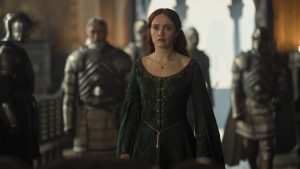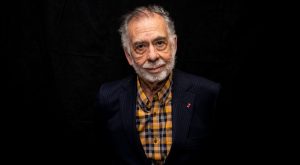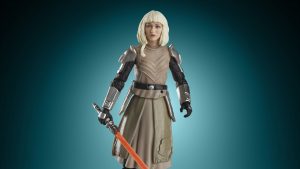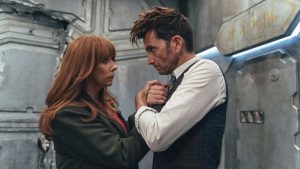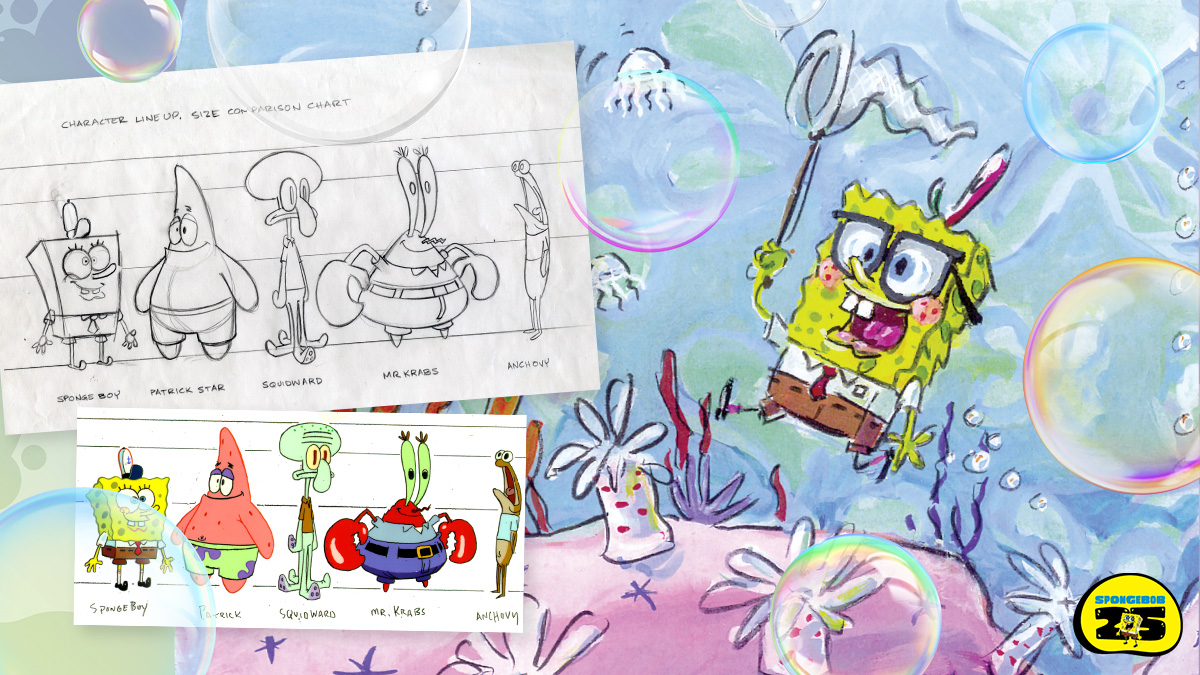
This article is presented by
Though it might be hard to imagine, there was once a world where it was impossible to take a swim in Bikini Bottom. Over two decades later, multiple generations have ventured under the waves to visit the kindest cartoon hero in his pineapple under the sea. SpongeBob SquarePants, now 14 seasons into its run, has been translated into over 60 languages, is the inspiration for multiple theme parks around the world, and is the heart of an ever-growing spinoff universe. But it all began with the late Stephen Hillenburg, whose uniquely unconventional approach to making the show was key to its success and longevity.
Love At First Sight
“My audition was unlike any audition I’ve ever had before or since,” Bill Fagerbakke, who brings Patrick Star to life, recalls. Instead of recording his audition for the role in his agent’s office or at a nearby studio, the actor was pleasantly surprised to find himself in a conference room with an unassuming Hillenburg, who had a tiny cassette deck sitting next to him with a plugin mic.
“I thought, ‘This is interesting.’ He had single-panel drawings of all the characters. He was just so gentle. He said, ‘Okay, I want to hear you read for SpongeBob’s best friend.’ So he played Tom Kenny for me and told me that Patrick would need to balance him out, which was my wheelhouse. I’m a professional moron if you will,” Fagerbakke laughs. “Luckily, he saw me as the character.”
Carolyn Lawrence had a similar experience when she read for Sandy. Wandering into what could have been anything from her third to billionth callback, she found herself in a conference room with Hillenburg—armed once again with a microphone.
“It was an unusual setup! It was so informal. In a way, it almost made me more nervous,” Lawrence shares. “It set the tone for the whole thing because he did things the way he wanted to do them. That’s a beautiful skill; so many creatives don’t have that opportunity, so there’s something innately powerful in him that he was able to manifest it that way.”
It would go on to be Lawrence’s first full series booking and the beginning of a 25-year journey as the adventurous squirrel known as Sandy Cheeks. “It was so exciting for me, but I had no idea what it would become. No one did, no matter what they say.”
Memories of an unusual audition process for the role of SpongeBob is something that prolific voice actor Tom Kenny immediately recalls. “Steve had me go to his house! I went over, and we went into his back office, and he said, ‘There’s a show I’ve been thinking about pitching at Nickelodeon; I’d like you to be the title character. So see what you think of it and if you would be interested.’ What actor isn’t interested in getting paid? Like, I don’t even have to look at it; the answer is yes,” he laughs.
Hillenburg shared the show bible with Kenny, introducing him to all of the Bikini Bottom residents, including Mr. Krabs, Squidward, and, of course, SpongeBob. There was one thing in particular that immediately stood out. “These little concept drawings of the characters doing different things in their lives were super charming. Black-and-white pencil drawings in Steve’s inimitable style. The way he drew the characters, I can instantly pick it out, you know?”
“My earliest memory is him walking me through the world and me just falling in love at first sight,” Kenny shares. The memories are extra fresh for the actor, who recently found himself near the apartment where that first meeting happened.
“I was actually recently just over in that area, and all the memories came rushing back. I was driving by; I almost had to pull over.”
Mr. Lawrence, who plays Plankton on the show, had known Hillenburg for years before SpongeBob, thanks to their work on another cult classic animation, Rocko’s Modern Life. “We were best buddies doing that show and learning about it,” he says.
“We had similar sensibilities, similar ways that we told jokes, and both of us had shows we wanted to get made. Steve’s got through the Hollywood gauntlet, and so Steve called me up—and if I had gotten my show at that time, I would have called him, too.”
Soon, Hillenburg recorded this pilot with Mr. Lawrence auditioning for every single character. “I actually did the Plankton voice for SpongeBob. It was stupid, but I got big laughs from it. And afterward, Steve came up to me and said, ‘If I had any guts at all, I’d go with your voice as SpongeBob because it’s this deep, crazy voice. But this doesn’t feel like it’s it. But I think it’s Plankton.’”
Hillenburg wrangled to have his lesser-known cast lead the series and hired Kenny without really doing wide auditions for SpongeBob, which was something the actor remembers well. “There were Nickelodeon folks who wanted to cover their butts a little bit, like, ‘Maybe we should listen to a couple others and judge them against each other?’ You know, they probably should have done that!” Kenny laughs. “But Steve was like, ‘Nope, I’ve got my SpongeBob, he fought for me.’”
He did cast one sure thing, though: legendary character actor Clancy Brown, who read for the role of Mr. Eugene Krabs, SpongeBob’s spendthrift boss who would go on to become a fan-favorite character. “Donna Grillo [the series’ casting director] sent a script to my manager, and I read it, and told him I’d be happy to audition for it, but I have no idea what’s going on in this thing,” Brown recalls.
Once he got in the room and heard the other characters come to life, he had a realization: “Was this one special? Yes, it was.” But when it comes to the single memory that stands out from those early days for Brown, it’s something that’s still true to this day. “This is the most fun I’ve ever had. We had a lot of fun recording the pilot, and it’s always been fun. It’s never not been fun.”
Another cast member who has fond memories of that auspicious first recording is Rodger Bumpass, the voice of Squidward on the now iconic show. “I remember that first day very clearly. In fact, because it’s in Burbank, I often pass by that studio—we didn’t record at Nickelodeon at that time—a little studio called Porto Studios, which has since been taken over by other people, but the building is still there,” he recalls. “That’s the first day I met Steve, Bill, Tom, and Clancy. We were the ones in the first episode. It was amazing.”
A Dawning Realization
After crafting their little family of oddball under-the-sea adventurers, the cast settled into the life of making an animated TV series as the world fell in love with SpongeBob and his friends. It was around season three when Mr. Lawrence first realized that the show was growing into something bigger than he originally could have imagined.
“I just remember standing on a corner when a car pulled up, and there was a SpongeBob air freshener hanging from the rearview mirror. I was just going past, and I thought, ‘Wow, people are responding to it.’ We were seeing it everywhere, but that moment mixed with the recognition becoming bigger, like everybody was paying more attention. When I would go to meetings, if I were trying to pitch something, it was different. It’s like the show had arrived, but I hadn’t realized.”
The massive success of the show first started to dawn on Carolyn Lawrence when she saw merchandise popping up in her everyday life. “I have a distinct memory of being in Target, and there was merchandise, and I was standing behind a kid who was talking to his mom about buying something. And I had that moment of like, ‘This is so weird. Like, should I explain to them? Do I say who I am? Would they even believe me? Do I even believe me?’ That was probably the most surreal of all those moments.”
For one of the cast members, the explosion of merchandise inspired their own impressive collection that’s about to become Guinness-certified. Rodger Bumpass, who brings Squidward to life, has an extensive collection inspired by the eclectic nature of the SpongeBob ephemera, which made the voice actors realize just how much of a smash they had on their hands.
“When I would go into a place like Target, what got my attention was that it wasn’t just in the toy section; it was in the bathroom section, it was in the kitchen section. It was in the auto supply, cards, and video sections. Every single department had representation of our stuff. So I said, ‘You know, I’m a collecting kind of obsessive guy, I think I’m gonna start doing this.’ And it outgrew my apartment at the time. Now it’s outgrown my house, and I’m submitting to Guinness as I genuinely believe that I have the largest collection.”
For Fagerbakke, the realization that they had created something bigger than they ever expected came in a far more personal shape, taking place at the gates of the school where he picked up his daughters.
“A sea of 20 seven- to nine-year-olds would just come running at me screaming, ‘Patrick! Patrick! Patrick!’” he laughs. “I was thinking, ‘What’s happening, what’s going on?’ That was really, really something. That was really great.”
He also recalls the moment he felt that SpongeBob had transcended into the true mainstream. “There were a couple of key media moments that were significant,” Fagerbakke says. “The New Yorker, I think, wrote a full-page printed feature on our crazy little cartoon, and The Wall Street Journal, I think, also had this article on SpongeBob.”
Even then, Fagerbakke, the cast, and SpongeBob’s creator weren’t certain of any kind of longevity, let alone for two-plus decades. “It wasn’t until we got wind of them wanting to do a film that the show really kind of built into something that was going to be more than just a cartoon in production for three seasons. That very easily could have been. I think that was part of the momentum that carried us into season four, and then that first film was so delightful. That was really a reflection of Hillenberg’s vision of the show.”
The 2004 movie cemented the success of the series, and ended up bringing current SpongeBob EP Vincent Waller back into the fold after an early exit. “Early in the series, I got hired on SpongeBob and I did about a season and a half before they fired me,” he laughs.
His return as a technical director for season four would be auspicious and mark the arrival of an important member of the SpongeBob family. Waller had begun his career as a caricature artist at Six Flags before moving to LA and getting work on iconic shows such as The Real Ghostbusters, Captain Planet, Ren & Stimpy, Cow and Chicken, and many, many more. His brief stint on SpongeBob originally only lasted a year, but after his return in 2005, Waller never left—and he now steers the SpongeBob ship alongside Marc Ceccarelli, another creator who worked on SpongeBob for years before he finally joined the team full-time in 2010.
“It was a baptism by fire,” he shares. Together, the pair built up extensive credits on the series and found themselves in charge of not only the original series but also showrunning new additions such as Kamp Koral. How does it feel to have taken that decades-long journey and end up in charge of something that means so much to so many people?
“I mean, honestly, it is a dream come true. The crew we have is amazing. I mean, our schedule is insanely busy,” Waller says. “We’re both up at the crack of dawn and work well into the night. But it’s always fun doing it. My wife says all she ever hears coming out of the room when I’m working is laughter.”
“I just feel like I finally ended up where I belong,” Ceccarelli smiles. “Writing stories and coming up with just funny, surreal gags was something I had always been doing, even when I wasn’t doing it to get paid. So to find this place where that’s what I’m doing and making money doing it, it’s just like Vincent said, it’s a dream come true. I just feel like I’m finally home.”
The Powerful Impact of SpongeBob
Soon, the impact of SpongeBob had grown outside of the shelves of big box stores and movie screens and into people’s lives, as Brown recalls. “When it hit me that it was in the consciousness was when someone showed me a picture of a child’s headstone that had SpongeBob on it,” he says. “That got me. It still gets me. That’s deep. That’s when it went to the next level. Like, wow, this is something that’s special and super worthwhile if it can provide some kind of comfort and memory to that deeply tragic situation.”
Brown wasn’t the only one who saw the moving impact of SpongeBob in real life. As we speak to Mr. Lawrence, he sits in front of a portrait of Plankton painted by a young fan, and it has its own heartbreaking story attached to it. “That was done by a kid who had brain cancer who was in Make-A-Wish, and he did paintings of all the characters, and gave them to us,” he explains. “So he’s gone now, but, of course, I kept it here, and I see it every day, and there’s something in it that I can’t describe. Like, our show struck this kid enough that he was compelled to meet us and paint for us. So it’s very sad, but also sort of inspiring.”
The love SpongeBob SquarePants has inspired is something that the cast is deeply aware of, as Kenny explains. “It’s something that is in my consciousness every day, in a good way. Thanks to Steve, he hired us all, he gave us—the cast and crew—this gift, where we get to work on this thing that matters to people,” Kenny says. “And it’s mattered to people for a long time across generations, and that’s amazing.”
“Fans and kids make art, and that is always our favorite,” Brown shares. “I have a wall full of it, too. Yeah, it’s just the best ever. I actually got some fan mail that I haven’t opened because the whole envelope is illustrated, and it’s brilliant. And I’m like, ‘This poor guy, he did such a beautiful job, and he’s totally screwed because I’m never going to open it.”
The Future of SpongeBob
The world of SpongeBob has expanded in the last few years with the addition of the prequel series Kamp Koral: SpongeBob’s Under Years, the sketch show-inspired The Patrick Star Show, and the upcoming Saving Bikini Bottom: The Sandy Cheeks Movie. For the man behind the titular character, the world expanding means one thing. “It’s another SpongeBob job!” Kenny says. “I’m just happy to still be this character in all these iterations; each one is a unique puzzle.”
With The Sandy Cheeks Movie on the horizon, Carolyn Lawrence has never been happier, seeing her colleagues as more than even close friends. “I always say we’ve become that crazy family,” she laughs. “All families have that relative you really, really like, and then you have that relative who kind of makes you crazy, that relative who really, really annoys you, whatever it is, but you love them all.”
That’s unique in show business and something she credits to SpongeBob creator Hillenburg.
“I don’t know, I think a lot of casts truly don’t get along,” she says. “But we’re different. And I think that goes back to the magic of Steve and how he innately knew that we’d be good as humans together, not just as actors.”
For Claudia Spinelli, the executive in charge of production on SpongeBob SquarePants, being involved with a show that’s so massively successful and beloved still feels surprising. “All the people who work on the show, everybody’s very down to earth,” she says. “Everybody’s very grounded, very humble about it. I think it’s just become a part of our everyday lives; I wonder what it feels like to be on the outside looking in.”
As for what excites her the most about the next era of SpongeBob, Spinelli is full of ideas. “I’m excited to continue to explore other characters and what we can do with them,” she says. “The ones that we don’t quite know so much about but who we’ve teased in the past, like Mr. Krabs, are such legendary figures; that’s a character I’m eager to see what we can do with.”
When it comes to the man who brings the owner of the Krusty Krab to life, he’s already satisfied. Well, for the most part. “Mr. Krabs has fulfilled every dream. He’s been a sword-fighting swashbuckler, he’s been a commander in a war movie,” Brown says. “He’s done all these characters that I would love to do.”
So what does Brown dream of for Krabs, then? “I just want to see him hand over a giant check and try to cash it or something. I’ll throw that out to the writers. That’s the dream scenario.”
No matter how the SpongeBob universe shifts or grows, the heart of the character and the series’ humble roots are key to its longevity. That’s why people still love it as much as they do, Kenny tells us. “I think maybe that’s why SpongeBob has continued to survive and thrive even in the gigantic hole that Steve left in his absence,” he says. “It’s still an animated show—a cartoony cartoon that’s run by animators who know the bolts of animation through and through.”
The post The SpongeBob SquarePants Cast Revisit 25 Years of Building a Cultural Phenomenon appeared first on Den of Geek.

